Greenwich Park in London is one of those places that not only a true lover of England, but every traveler should see. Since I consider myself to be both, Greenwich was high on my list of must-see attractions, if not first, then certainly in the top ten.
Where is Greenwich Park located? Historical background
The Borough of Greenwich (not to be confused with the New York neighborhood of Greenwich Village) is located in southeast London and is rightfully considered the sea gate of the British capital. And the story began with the fact that on the site of Greenwich there was a small fishing village. Gradually it grew, and several hundred years ago Greenwich Park became one of the favorite hunting grounds of British monarchs. In the 15th century, the Duke built the Bella Court mansion here, and soon the park was fenced off to prevent unnecessary visitors from entering. The next two hundred years Greenwich Park monarchs came to hunt. King James I greatly favored Greenwich and even ordered an estate to be built as a gift for his wife. However, subsequent monarchs still preferred Buckingham Palace to Greenwich. In 1675, the Royal Observatory was built according to the design of the famous architect Christopher Wren. In 1997, Greenwich received the status of a London borough and became one of the famous areas of London. Nowadays, the park is open to everyone, and Greenwich is one of the most respectable boroughs in London.
How to get there
When I first got to the city, Oyster Card travel cards were still in use there, valid by zone. Therefore, when we were deciding how to get to Greenwich, we didn’t have much to choose from. We lived in the second zone, the cards were valid for two zones, and accordingly, the road was selected in such a way that transport did not go beyond their limits. This route remains the most optimal in terms of speed and price today, even though in London now any Oyster Card is valid in all zones and for any type of transport. Therefore, you can use the Oyster Card when traveling on the metro, bus, water bus, light metro and train. The price for these types of transport is the same and depends on which zone you come from. The minimum amount that will be debited from your travel pass is €1.4 (£1.2) for travel in one or two zones.
- So, option one is to take the DLR to one of three stations - Greenwich, Cutty Sark for Maritime Greenwich or Island Gardens. The first two are located directly in the Greenwich area, and therefore are closer to the park and main attractions. The path from Island Gardens is a little longer, but more exciting. To get to Greenwich from this tube station, you need to go through the pedestrian tunnel under the Thames (Greenwich Foot Tunnel). The tunnel exits directly next to the sailing ship Cutty Sark.
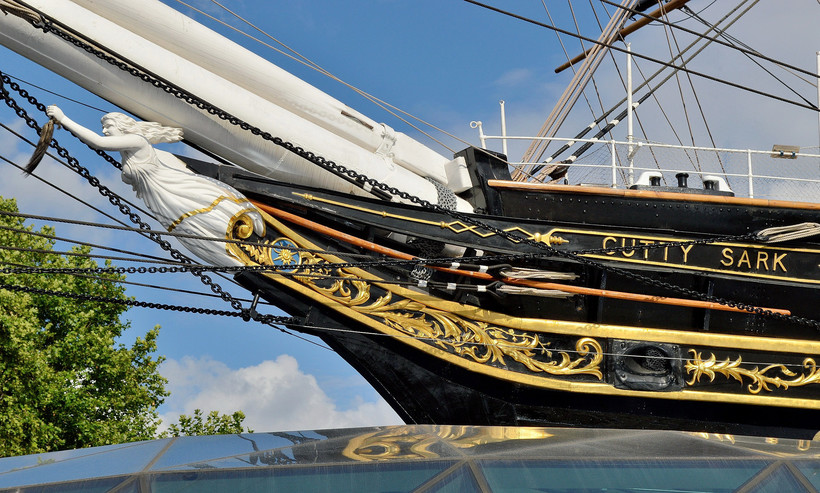
- The second option is to take a regular London bus. There are quite a lot of routes going to Greenwich and passing by. There are also night ones. The starting points of their journey are very different, starting from Woolwich and ending with Tottenham Court Road. You may find bus numbers 129, 177, 180, 188, 199, 286 and 386 useful.
- There is an option to get by train to Maze Hill or Greenwich station. Not very convenient, since you have to adjust to the train schedule and you can spend extra time to wait. Although they still go quite often. The schedule is always on the board at each station. Or you can find it on the Internet on the official website. Maz Hill is in the third zone, so minimum price If you travel from the center from London Bridge station, it will be 1.8 € (1.5 £).
- Can be reached by water bus. You will need to get off at North Greenwich station. Payment there is also possible using an Oyster Card, although it will be a little more expensive than a regular trip, almost 4 €. However, a ride along the Thames is worth it. The disadvantage of this method is that river trams run much less frequently than surface and underground transport. So be prepared to wait.
- Take the regular underground to North Greenwich station. On the London Underground map this station can be found on the Jubilee line.
- Lovers of local flavor can take a taxi, but I strongly do not recommend it. Typical London black cabs are very, very expensive. It’s easier to take the subway back and forth ten times. Or even twenty, depending on where you’re going from. The price, as in any taxi, is calculated based on the length of the journey. On average, if you drive for about 10-20 minutes, you will have to pay up to 18 €. Converted to local currency it would be £15.
Greenwich attractions
Greenwich is home to many of London's attractions, so my recommendation is to set aside a full day to explore it. I got off at Cutty Sark station around ten in the morning and left through the Thames Tunnel at around five in the evening. However, I am a very meticulous tourist, who also loves to walk a lot and persistently and admire the exhibits in museums. It’s better to choose the time... well, whatever time you want :) There are always tourists in Greenwich, from morning to evening. But if you want to avoid crowds, then the morning hours, from about 10 to 12, are more suitable.
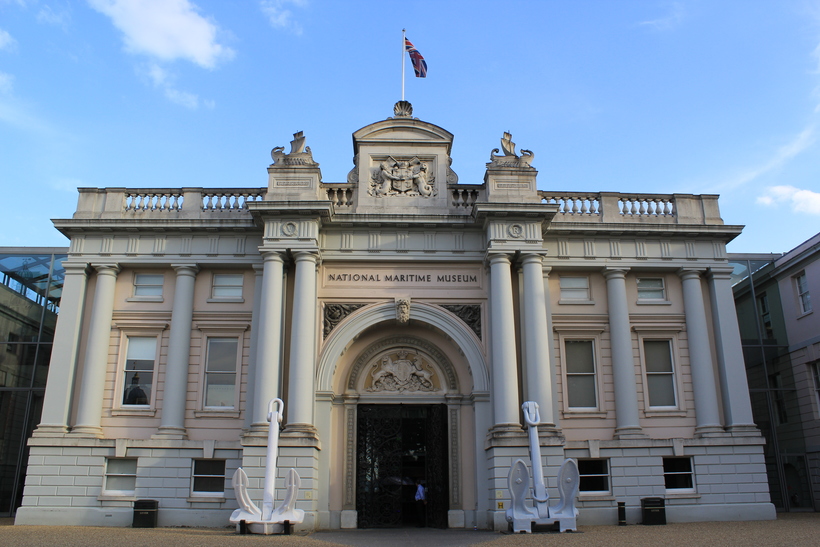
- The first thing that appears to the eyes of park visitors is Greenwich Park itself, Queen’s House and the National Maritime Museum. Be prepared for a long walk through the park and up a hill to get to the Royal Observatory Greenwich. However, it is difficult to get lost there. There are signs at every step in the park. And even if you don't know English language, then it’s not scary, the signs are very easy to understand. You don’t even have to read the signs, but simply follow the crowd of people who are slowly and systematically climbing to the top of the hill. There is only one road up there, so you definitely won’t get lost. When doing this, don't forget to look not only at the observatory, but also look back at Greenwich Park. In general, it is famous for its parks, and this one honorably supports the brand. From Greenwich Hill you can see the Queens House palace in the park and the Greenwich Hospital surrounding it. The palace was built in the 17th century as a gift to Queen Anne of Denmark. However, the royal family and their descendants did not live here. Queens House subsequently became part of the National Maritime Museum and now houses an art gallery. Admission to Queens House and the National Maritime Museum is free, and they are open from 10.00 to 17.00. Greenwich Park itself opens for walks from 6 a.m. and closes when it gets dark. Finding Queens House and the National Maritime Museum is easy as they are located right at the entrance to the park.
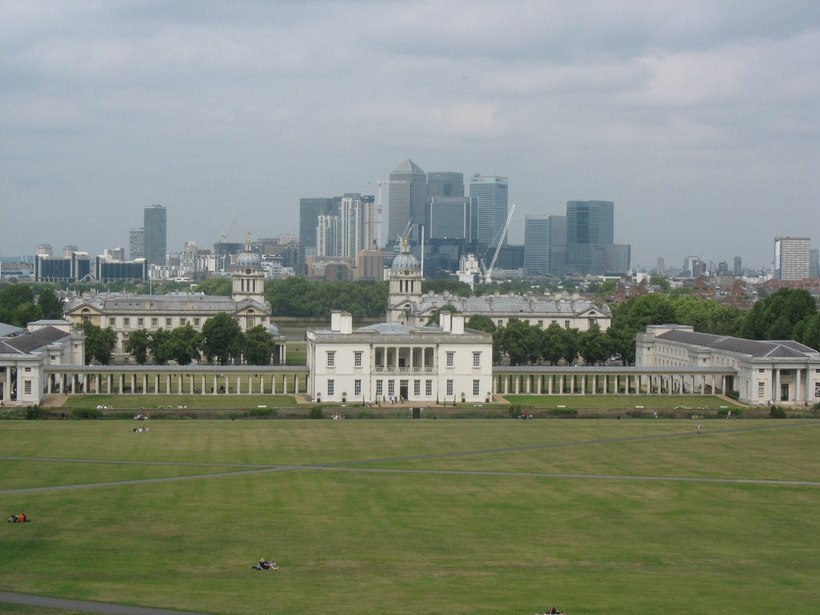
- Across the road from Queens House is the University of Greenwich. This is not only an amazingly beautiful building, but also the largest London university in terms of number of students. This can be noticed when you get closer, the number of young people rushing to or from school, depending on the time, is very large. The history of the University of Greenwich dates back to 1890, although the status of the university is educational institution appeared only in 1992. Nowadays, this university is considered one of the most prestigious in England.
- Having climbed the hill, everyone, of course, immediately rushes to see the famous line of the Greenwich meridian (Prime meridian (Greenwich)), which is located in the courtyard of the Royal Greenwich Observatory. And it is advisable to take a photo there, so if such a desire arises, be prepared to stand in a short line for the right to take historical photo with yourself in the leading role. The Royal Observatory is located at the very top of Greenwich Hill, giving stunning views of the park and surrounding areas in all directions. In the courtyard with the meridian line, at exactly noon, a red ball rises above the roof of the Observatory, thanks to which, at exactly noon, you can set your watch to the Greenwich time zone. To enter the courtyard, you need to pay 11.30 € (9.5 £), the payment includes passage to the Royal Observatory, and not just to the courtyard with the Greenwich meridian line. The observatory and courtyard are open from 10 a.m. to 5 p.m.
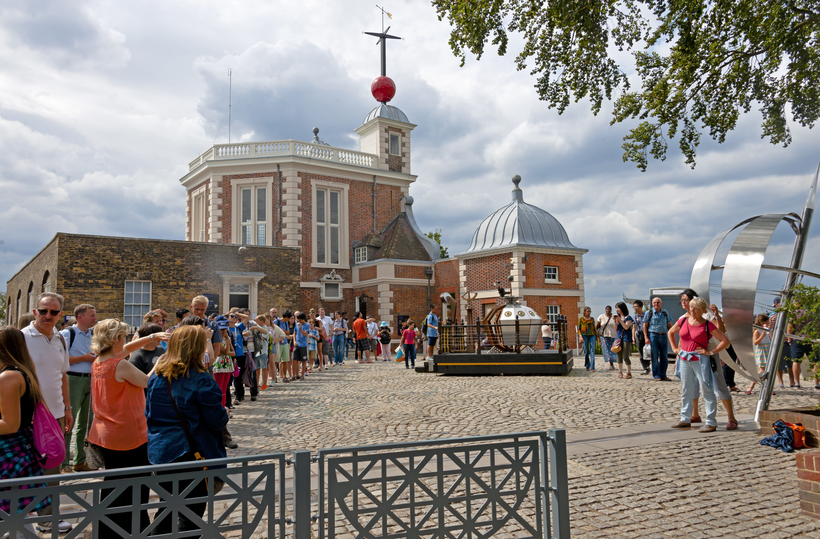
- The Royal Observatory itself, in addition to the Greenwich meridian, contains many more interesting things. Museum of Astronomical and Navigational Instruments with an interesting exhibition of timekeeping (Museum Astronomical and Navigational Instruments), as well as a planetarium with numerous displays (Peter Harrison Planetarium). Museums adjacent to the observatory are open from 10 a.m. to 5 p.m. You will need to pay separately for visiting the planetarium, and for each show. The Museum of Astronomical and Navigational Instruments is part of the National Maritime Museum, so admission is free.
- On the banks of the Thames in dry dock lies the Cutty Sark, a famous tea clipper. Since 1869, the Cutty Sark transported tea from China to Great Britain. The clipper became famous for its legendary race with its colleague, the Thermopylae clipper. Both sailing ships left Shanghai at the same time, but on the way, the Cutty Sark's rudder broke. However, the team managed to fix the damage on the high seas, and the clipper reached London without visiting the port for repairs. Although the Cutty Sark was a week behind the Thermopylae, the courage and resourcefulness of the captain and sailors attracted everyone's attention to the Cutty Sark. Since the mid-20th century, the famous sailing ship has become a museum ship. Entrance costs €16 (£13.50), but I recommend not skimping. There is something to see on board, because they tried to preserve it in the same form in which it transported tea from China to England. The clipper is open to the public every day from 10 a.m. to 5 p.m., and in the summer until 6 p.m.
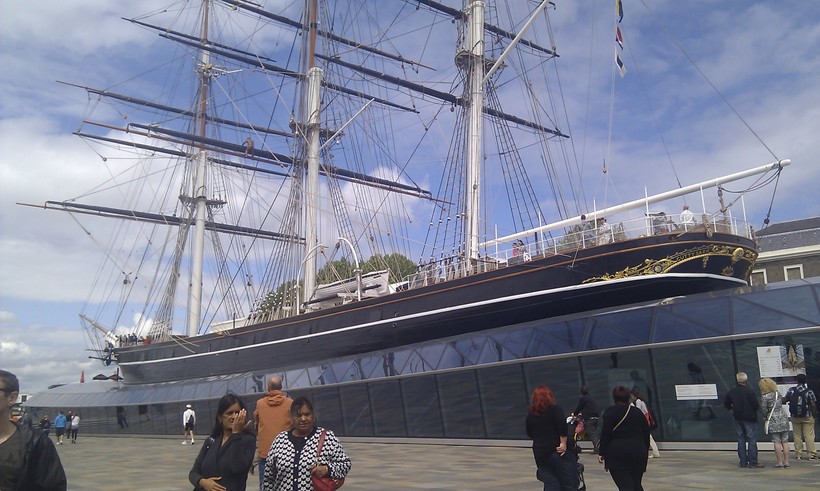
Ticket prices for Greenwich museums
Museums in Greenwich are mostly paid, but you can save money if you take a ticket to several museums at once. This is beneficial if you plan to spend the whole day walking around Greenwich. There are discounts for children as well as family tickets.
Tickets to the Royal Observatory:
- adult ticket – 11.30 € (9.50 £);
- children (from 3 to 15 years) – 6 € (5 £);
- family (1 adult, 2 children) – 17.80 € (15 £);
- family (2 adults, 2 children) – 26.10 € (22 £);
- preferential (students, pensioners over 60 years old, military, disabled) – 8.90 € (7.50 £).
Tickets for Cutty Sark:
- adult ticket – 16 € (13.50 £);
- children (from 3 to 15 years) – 8.30 € (7 £);
- family (1 adult, 2 children) – 28.50 € (24 £);
- family (2 adults, 2 children) – 41.50 € (35 £);
- preferential (students, pensioners over 60 years old, military, disabled) – 13.60 € (11.50 £).
Tickets for one show at the planetarium:
- adult ticket – 8.90 € (7.50 £);
- children (from 3 to 15 years) – 6.50 € (5.50 £);
- family (1 adult, 2 children) – 18.40 € (15.50 £);
- family (2 adults, 2 children) – 23.70 € (20 £);
- preferential (students, pensioners over 60 years old, military, disabled) – 7.70 € (6.50 £).
So how can you save on museum tickets? Buy an all-inclusive ticket that includes entry to the Cutty Sark and the Royal Observatory. The prices for it will be as follows.
- adult ticket – 22 € (18.50 £);
- children (from 3 to 15 years) – 10 € (8.50 £);
- preferential (students, pensioners over 60 years old, military, disabled) – 18.40 € (15.50 £).
The second option for a combined ticket is admission to the Royal Observatory and one of the planetarium shows.
- adult – 14.50 € (12.50 £);
- children (from 3 to 15 years) – 7.70 € (6.50 £);
- family (1 adult, 2 children) – 22 € (18.50 £);
- family (2 adults, 2 children) – 32.60 € (27.50 £);
- preferential (students, pensioners over 60 years old, military, disabled) – 11.30 € (9.50 £).
If you don’t want to stand in line, you can buy tickets online on the Greenwich Museums website.
What you need to consider
- Greenwich Hill is not Everest, of course, but it still takes quite a long time to climb there, so it is advisable to leave shoes with slippery soles, as well as high heels and stilettos at home.
- Stock up on water, especially in hot weather. It is not necessary to take food, but after climbing the hill it is worth quenching your thirst. There are drinks in the cafe at the museum of navigational instruments, but like in any tourist place they are disproportionately expensive.
- You should also stock up on money if you plan to take a photo at the very mark in front of the window from which at night a green beam shines, showing the prime meridian of Greenwich. However, many tourists, having decided to save money, easily photograph the mark through the bars. This is not prohibited here. And in general, as I already said, in Greenwich you have to pay for pleasure, so a small reserve in your wallet will not be superfluous.
Where to eat
There are a lot of restaurants, cafes and pubs in Greenwich. After all, it’s a tourist place :) Since Greenwich is considered a sea gate, you can find fish dishes on the menu almost everywhere. In addition to fish, there is always the obligatory fish and chips in England and meat dishes. In short, you won't remain hungry :)
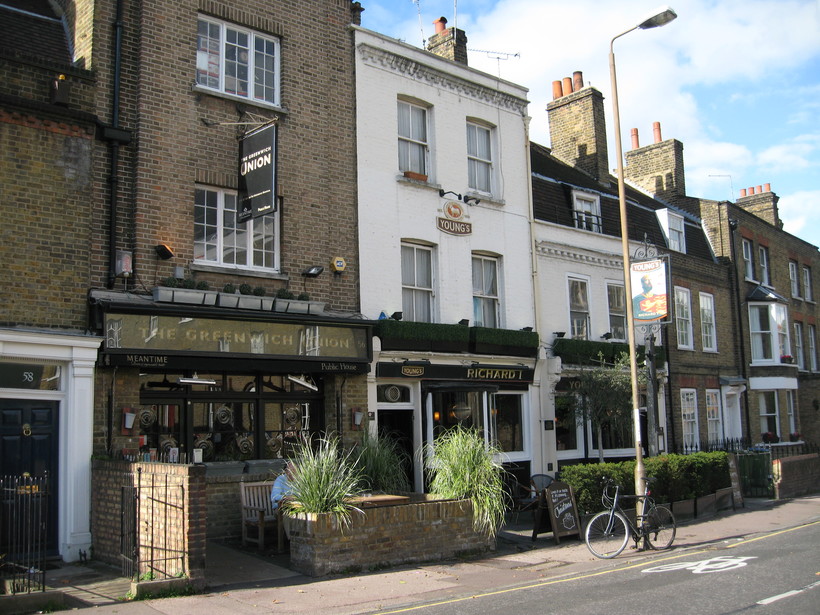
In search of more interesting places, I recommend walking along the embankment and taking a closer look at one of the pubs or restaurants on the banks of the Thames. They are almost all imprisoned marine theme, so you can not only have a tasty meal, but also admire the halls decorated in the style of sailor taverns. If you want to save money, it's better to go to the pub. The food there is cheaper than in restaurants, and the choice is almost the same.
Where to buy souvenirs
If you want to buy yourself something to remember your visit to Greenwich, then you can pay attention to the surrounding streets of the city. There are many shops near Greenwich Park that are filled with souvenirs, typical for lovers of astronomy, navigation and those looking for a colorful reminder of Greenwich. Those who have visited the Navigational Instruments Museum, the Royal Observatory or the Cutty Sark can browse the wares in the museum shops. There is no overpricing there, everything costs about the same as souvenirs in street shops, from magnets for 2 € to mugs with symbols for 8 €. And the range is about the same. By the way, if you are interested in books about maritime affairs or the history of navigation and astronomy, it is better to look for them in museum stores.
Greenwich Park (English: Greenwich Park) is a public park complex with an area of 74 hectares. The main attractions of the park are the center wildlife.
Like many others, Greenwich Park was originally a royal game reserve for hunting - in the 15th century for falconry, then for deer. At the end of the 17th century, the famous one appeared here. It is believed that the French architect and landscape designer Andre Le Nôtre, the author of the royal palace and park complex at Versailles, was involved in the planning of the park at that time. In the 18th century, the park became a place of public access, and during the Second World War, anti-aircraft batteries were placed here, which met waves of German bombers. Today, Greenwich Park is known, among other things, as the venue for equestrian and pentathlon competitions during the 2012 Olympics.
In Greenwich Park you can see the Oak of Elizabeth I (planted in the 12th century), a statue of General James Wolfe (victor of the Battle of Quebec), a beautiful rose garden, a small garden with culinary plants, a sundial and a planetarium. In addition, there is a nature reserve wildlife center, where a herd of wild deer and fallow deer lives. You can look at them through special one-way windows. In addition to deer and fallow deer, the park is home to 70 species of wild birds, and large pipistrelle bats live in the treetops.
 |
 |
|
 |
 |
 |
|
 |
 |
 |
 |
 |
 |
 |
 |
| work schedule: | |||||
| April - September | October - March | ||||
|
06:00 - 20:00 06:00 - 20:00 06:00 - 20:00 06:00 - 20:00 06:00 - 20:00 06:00 - 20:00 06:00 - 20:00 |
Mon Tue Wed Thu Fri Sat Sun |
06:00 - 18:00 06:00 - 18:00 06:00 - 18:00 06:00 - 18:00 06:00 - 18:00 06:00 - 18:00 06:00 - 18:00 |
|||
| ticket prices: | |||||
| free entry | |||||
| useful links: | |||||
| official website | |||||
| address: | |||||
| Greenwich, London | |||||
Greenwich Park is an old hunting park in Greenwich and one of the largest green spaces in south-east London. One of London's Royal Parks and the first to be enclosed (in 1433), it covers an area of 183 acres (0.7 km2). From here they open beautiful views to the Thames, Isle of Dogs and Central London. The park is open from 6 am for pedestrians and from 7 am for vehicles throughout the day, and closes at dusk.
Geography
The park is a rectangle with sides 1000 meters by 750 meters. The park stretches along the hillside and is located on two levels. The lower level (adjacent to the Museum, the Royal House and, beyond them, the River Thames) is located to the north; climbing up steep slope hill you come to a wide area.
Right in the center, on top of the hill, is the Royal Observatory Greenwich. To the north are the National Maritime Museum and the Royal House, and beyond them is Greenwich Hospital. To the west is Vanbruch Castle. To the south is Blackheath, and to the southwest is Wanderer's House, overlooking the moor. To the west lie several architecturally correct streets: Chesterfield Alley and Crome Hill.
Facilities
On the lower level of the park there is a popular children's playground playground(northeast corner, next to Maze Hill tube station) and adjacent lake with boat dock. There is also a herbarium here (next to the entrance to the center of Greenwich).
On the upper level there is flower garden with a pond and ducks, a rose garden, a cricket pitch, many 17th century chestnut trees, a tennis court, a bandstand, Roman ruins, an old oak tree (the "Royal Oak", after Queen Elizabeth I) and a fenced nature reserve where several wild deer.
Sport
When London hosts the 2012 Summer Olympics, Greenwich Park will host horse racing, show jumping and the running disciplines of modern pentathlon. Park also competed in the final stage of the 2006 Tour of Britain, a circuit race (3 September). The Greenwich Meridian Festival is celebrated in March every year.
Greenwich Park, located in the London suburb of the same name (which, in turn, is part of the so-called Greater London), is one of the largest parks in the British capital. In addition, Greenwich Park (originally in English - Greenwich Park) has its own history, which is full of interesting moments.
In southeast London, this is the largest green area, which was originally a hunting ground (there is actually nothing surprising here; almost all parks in London at one time served this function). According to the generally accepted version, the park was fenced and declared a Royal Hunting Grounds back in 1433. Greenwich Park (then, of course, it did not have that name) gained particular popularity during the reign of King James I. In fact, it was James who surrounded the park stone wall and forbade visitors from entering. In 1662, Andre Le Nôtre, the legendary architect, the most famous master of that era, developed a unique project for the development of the park, but this project was only partially implemented.
Until the end of the 20th century, Greenwich Park changed significantly, primarily due to elements landscape design. IN different times were built on its territory various buildings and bright architectural structures, some of which have survived to this day and are full-fledged attractions. At the moment, Greenwich Park covers an area of 183 acres, offering amazing views of the legendary Thames, the park is landscaped and truly beautiful.
Greenwich Park: starting from scratch
Of course, Greenwich Park is primarily the prime meridian. That is, it is here that the same hypothetical strip passes that divides our planet into the eastern and western hemispheres. The most accurate clocks in the world are located here; all time zones are “counted” from here. In fact, in Greenwich there is even a shiny line, which serves as that very “dividing strip”. Of course, there is a corresponding legend associated with this: it is believed that if you stand with one foot on one side of the strip (in the eastern hemisphere), and put the other foot on the other side (western hemisphere), and stand like that for a couple of minutes, making a wish, then it will definitely come true .
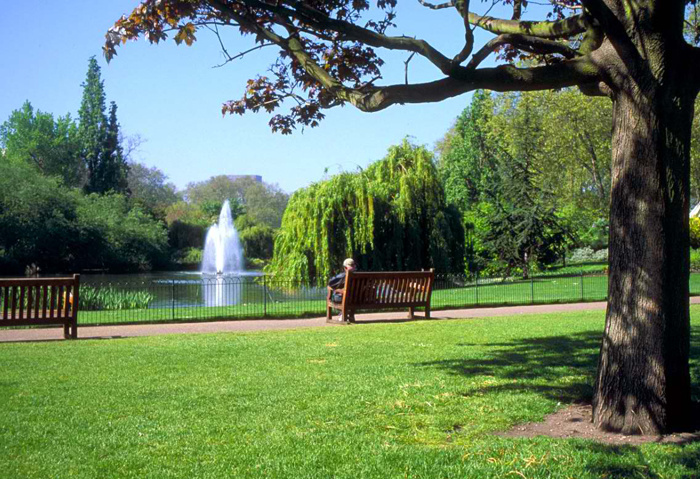
The shiny stripe itself stainless steel passes through the courtyard of the Greenwich Observatory (to which we, of course, will return), and since 1993, the sky over Greenwich Park, as well as over all of London, has been illuminated by a powerful green laser beam. The beam comes from the observatory and is directed due north.
Royal Observatory: where the world begins
Without a doubt the main attraction Greenwich Park– Greenwich Royal Observatory (aka just the Royal Observatory). The observatory dates back to 1675, from the moment when it was opened by King Charles II himself. Initially, the observatory was located on the territory of the suburb of Greenwich, and not at all where Greenwich Park is now located. The observatory was created to clarify the star coordinates, which were vital for navigators of the 17th century.
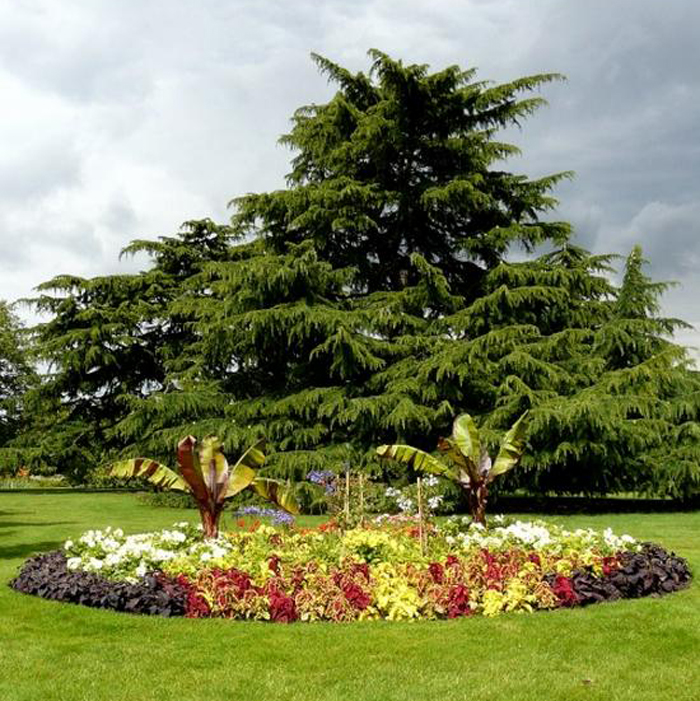
It should be noted that today only a small part of the Royal Observatory remains in Greenwich Park. In 1953, it was moved to Hurstmonceux Castle, which is located 70 kilometers southwest of Greenwich. However, let's be honest, Greenwich Park did not lose anything from this, because the original observatory building, designed by Christopher Wren himself, the greatest mathematician and architect of his time, remained in the park. In particular, the Flamsteed House building, which has survived to this day, was developed by Wren together with Robert Hooke; this is the first building in Britain aimed at solving purely scientific research problems.
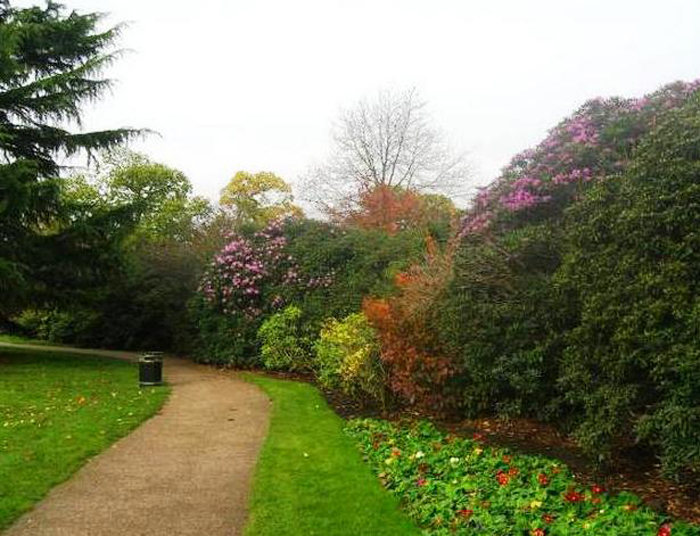
Flamsteed House was built on the site of Duke Humphrey's tower; the building is named after the outstanding astronomer John Flamsteed, who worked here at the observatory during the reign of Charles II. Today this building and many other structures located on the territory of Greenwich Park are part of the National Maritime Museum. Here tourists can visit exhibitions dedicated not only to astronomy, but also to navigation. There are many navigational and astronomical instruments here, for example the legendary John Harrison Chronometer (H4, it belongs to the British Ministry of Defense).
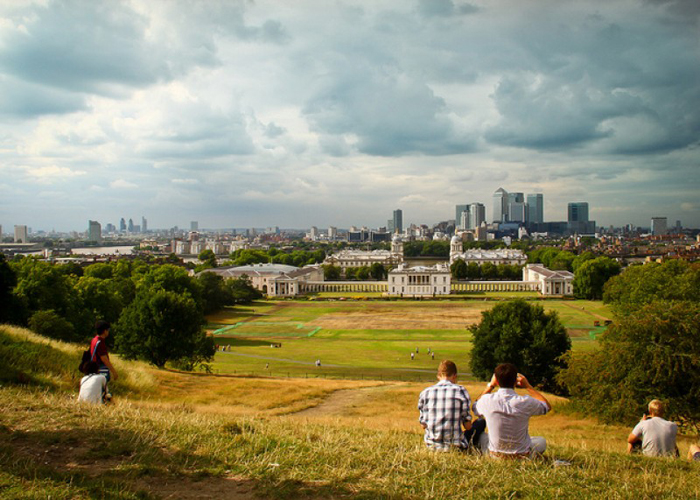
Also here you can see the famous astronomical clock, which was invented by Feodosius Mikhailovich Fedchenko in the mid-20th century. This is currently the most accurate pendulum clock in the world. There is also the equally famous Shepard watch - one of the first electronic watches in the world. And one more important point: relatively recently, in 2013, Greenwich Park, or rather the territory of the Royal Observatory, was replenished with another amazing attraction - a monument to Yuri Gagarin was opened here, which especially pleases tourists from Russia.
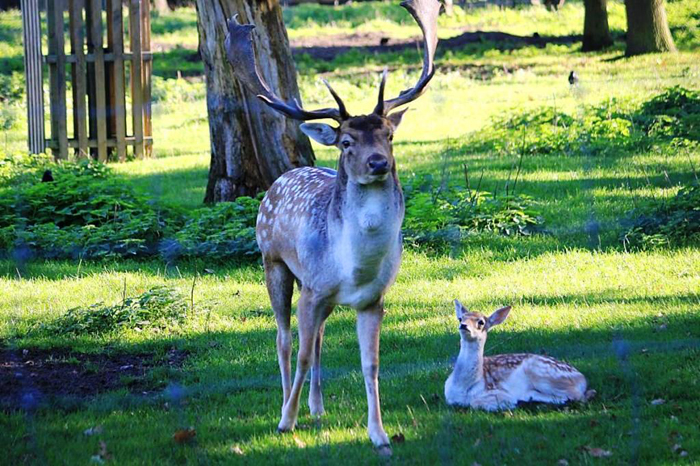
Actually, this is precisely what Greenwich Park (London) attracts visitors from all over the world, the Greenwich Observatory and the Maritime Museum. However, in addition to history, Greenwich Park also amazes with its landscapes. It’s really very beautiful here; there are a lot of plants planted in the park. ornamental trees and flowers, you can rent a bicycle and rush along narrow paths among the fragrance of bright, rich greenery. The park is home to many wild animals that you can watch. And in the southern part of Greenwich Park there are special terraces (45 meters above sea level), which offer amazing views of London. There is a market here where you can buy many interesting souvenirs. Many people choose a car excursion, which lasts as much as 4 hours. One way or another, Greenwich Park is definitely one of the most beautiful places London. When in the British capital, you should definitely visit this amazing place, where beauty and grace go hand in hand with the history of European science.
Greenwich Park is located in the place where the famous Greenwich meridian passes, dividing the Earth into the western and eastern hemispheres.
Greenwich Park has its own attractions, including the National Maritime Museum, the famous Christopher Wren Royal Observatory and the Cutty Sark, a sailing ship that was once used to transport tea. There is also a market where you can buy souvenirs, crafts, various art objects and some food products.
Greenwich Park is especially beautiful in the spring, when azaleas and rhododendrons bloom here. The beautiful landscapes of the park are considered an ideal place for picnics. Many visitors to the park are also attracted by the squirrels that live here, which feed from a huge box completely filled with nuts. And opposite the National Maritime Museum there is a special area where red deer live.
Just down the Thames there is a dam built after the great flood of 1953; the Thames Barrier protects the city from possible floods.
The entrance gate to Greenwich Park consists of two columns with gilded balls representing the Earth. The famous park was surrounded protective wall back in 1633 by order of King James I. Greenwich Park is the property of Her Majesty. The landscape planning of this wonderful park was carried out by the famous French architect Le Nôtre, who is also the author of the no less famous complex at Versailles.
The Royal Observatory is located on Greenwich Hill. The famous Greenwich meridian, which divides the globe into the eastern and western hemispheres, is marked here with a shiny stripe.
| | |




